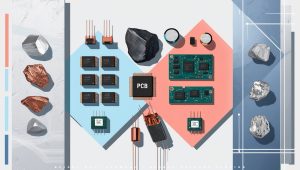
The Urgency of Now: Harnessing Africa’s Resources for Homegrown Electronics and Tech.
In the race to define the future through technology, Africa stands at a critical juncture. Despite possessing some of the world’s richest deposits of minerals essential for electronics manufacturing, the continent remains largely dependent on imports for its tech needs. This dependency is a stark contrast to countries like China, which, through a strategic mix of domestic resource utilization, global investments, and innovative recycling, has become a global leader in electronics manufacturing. This reality calls for immediate action from African leaders and youth to harness our resources and build a self-reliant, technologically advanced continent. 
Africa’s Wealth in Natural Resources: A Hidden Opportunity
Africa is blessed with an abundance of the very minerals that power the global electronics industry. From the cobalt-rich regions of the Democratic Republic of Congo (DRC) to the vast bauxite reserves in Guinea, our continent holds the keys to producing everything from smartphones to LED lights. Yet, these resources are often exported in their raw form, only to be imported back as finished products at significantly higher costs. This cycle not only drains Africa’s wealth but also stifles our potential for industrial growth and technological innovation.
The success story of China offers a powerful lesson for Africa. Despite being one of the largest producers of critical minerals, China doesn’t stop at extraction. Instead, it adds value by processing these minerals domestically and turning them into high-tech products. For instance, China is the world’s leading producer of rare earth elements, crucial for manufacturing components like LEDs and smartphones. This vertical integration—from mining to manufacturing—has enabled China to dominate global electronics markets.
The Cost of Inaction: Missing the Global Tech Revolution
While Africa lags, the rest of the world is surging ahead. The global demand for electronics is skyrocketing, and countries like China have positioned themselves as indispensable players in this market. China’s approach is not just about utilizing its domestic resources; it also involves significant investments in mining operations across the globe. Chinese companies have invested heavily in mining ventures in Africa, securing access to minerals like copper, cobalt, and bauxite. These investments ensure that Chinese manufacturers have a steady supply of raw materials, which they transform into high-value products.
The longer Africa delays, the harder it will be to catch up. The world’s technological landscape is rapidly evolving, and Africa risks being left behind if we do not take immediate steps to develop our own electronics manufacturing capabilities. The consequences of inaction are severe: continued economic dependency, limited job creation, and a failure to leverage our resources for the betterment of our people.
Strategic Actions: Lessons from China’s Success
Africa’s leaders must take a page from China’s playbook and implement policies that prioritize local processing and manufacturing. By investing in infrastructure, technology transfer, and education, African governments can create an environment conducive to electronics manufacturing. Strategic stockpiling of critical minerals, as seen in China, can also help mitigate the risks of global market fluctuations and supply chain disruptions, ensuring that African industries have the resources they need to thrive.
Moreover, Africa should explore opportunities for urban mining and recycling, much like China’s extensive electronic waste recycling initiatives. By recovering valuable materials from discarded electronics, Africa can reduce its dependence on raw material imports and support a more sustainable manufacturing sector.
The Role of African Youth: Catalysts for Change
The youth of Africa, who make up the majority of the continent’s population, are the key to unlocking our potential in the tech industry. With access to education and technology, African youth can lead the charge in innovation and entrepreneurship. By focusing on STEM (Science, Technology, Engineering, and Mathematics) education, gaining practical skills, and engaging in global tech networks, they can drive the development of homegrown tech solutions that meet Africa’s unique needs.
It’s time for African youth to advocate for policies that support local manufacturing and technological innovation. They must push for a shift from being consumers of foreign technology to becoming creators and innovators of our own. This shift will not only empower the next generation but also create jobs, boost the economy, and position Africa as a leader in the global tech industry.
The Way Forward: Seizing the Moment

Africa’s journey toward becoming a leader in electronics and technology manufacturing is fraught with challenges, but the potential rewards are immense. By following the example of China—leveraging our natural resources, investing in technology and education, and building robust manufacturing ecosystems—we can transform our continent from a mere supplier of raw materials into a powerhouse of innovation and industrial growth.
The time for action is now. African leaders must provide the vision and support necessary to build industries that will secure our future. The youth must rise to the occasion, harnessing their energy and creativity to drive innovation and progress. Together, we can ensure that Africa not only catches up but becomes a force to be reckoned with in the global tech industry.
The clock is ticking, but it’s not too late. Let’s seize this moment and build a brighter future for Africa—one that is powered by our resources, our people, and our determination to succeed. We have the resources, the talent, and the drive. Now is the time to act.
